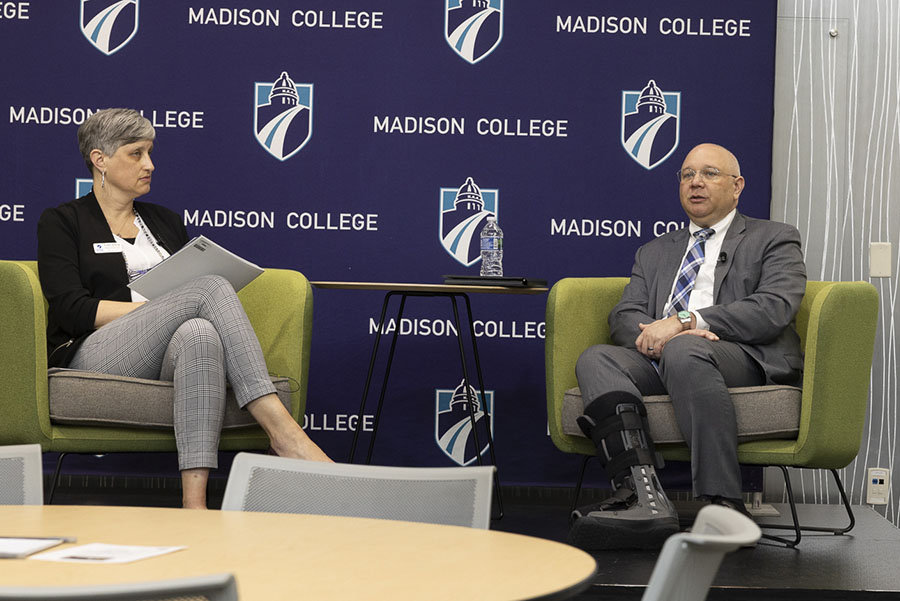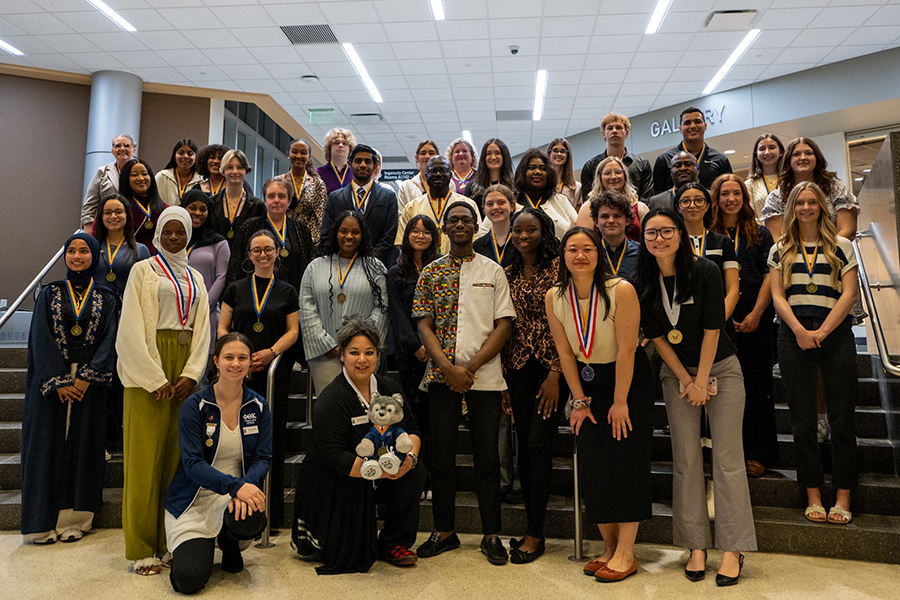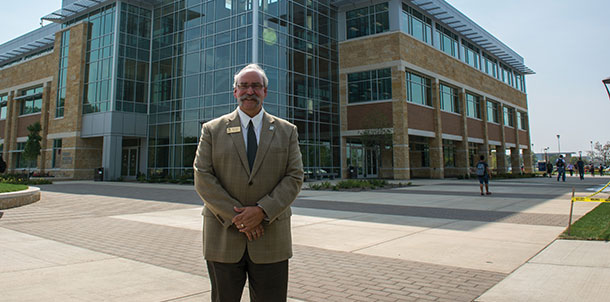As the new Health Education Center celebrates its official ribbon cutting Sept. 11, it’s the perfect time for some of the key contributors to reflect on a job well done. Possibly the most influential voice of the project was Dean of Health Mark Lausch. His lengthy resume and life-stories leading him here all equated to his vision of the new school being realized and he is “very proud.”
Lausch doesn’t believe that anyone sets out to be a dean, but his professional experiences helped mold him into the man he is today. Before setting foot in classroom as an instructor, he used his on the sports field.
“I played (as a goalkeeper and midfielder) for eight and a half years of pro soccer and 11 and a half, semi pro,” Lausch said. His career as a player ended after having two knee reconstructions and nine operations total. He still managed to stay close to the game as a coach of elite girls’ teams that went to state cup games before calling it quits this last season. As has often happened in Lausch’s career, one thing led to another. While being “a bit too busy with the building,” he wasn’t going to settle for less than his best and decided to focus on the task at hand.
Soccer transitioned into the rest of his professional ventures. “I was always competitive and had to be the fastest, run the longest and play the most minutes,” Lausch said. It was this dedication to success that led to the countless office hours and over-preparation.
“Right out of college I started my own software business developed artificial intelligence software for health companies,” he said. His company developed diagnostic software for the healthcare industry and had some of the top seven selling applications in the U.S. and Canada.
That soccer competition “bled over” to business and beyond. “Where I got my desire for teaching was when I was doing software,” Lausch said. He went to the companies that bought his software and trained them on it. As he was training more and more, he had to stop developing.
Lausch eventually ended up getting out of the business overnight. On his last project, he spent two years, two months and 22 days without a break or a day off. After he turned in his final application and got his final check, he was gone.
“The next Monday I started work as a seventh-grade homeroom teacher at a Catholic grammar school for $16,000 a year,” he said. From there, he started working on his master’s degree in education and kept learning and evolving.
He had an opportunity on consulting projects for the Centers for Disease Control, and then for the National Institutes of Health. While there, the professor he was working with advised him to get in public health where he got his masters and his doctorate in education. In between then, he worked on a top-secret project for the Naval Intelligence Agency.
After taking the job at Madison College, he was given the project of drafting an executive summary on what he thought the new health building should have. Instead of a standard 5-7 page summary, Lausch turned in a 293 page document that became the foundation for design. He was proud, saying his vision “turned out almost exactly how the building stands today.” He added that the project was completed “under budget and under the time requirements.”
Provost Terry Webb was the man who gave Lausch the task and is pleased with the results. “Clearly Mark (Lausch) was instrumental in the planning and development of the Health Education building. He organized the staff, faculty, and students to provide their input into this process. He then synthesized it all into a working plan for a world-class health education center. The result speaks for itself. The facility will serve the needs of our community for health care professionals for decades to come.”
Bigger and Better
Working at three other colleges on development projects helped Lausch see the bigger picture use a philosophy of letting things emerge and implement a holistic approach. Full credit and blame – interactive classrooms with labs being just steps away. His concept was to put “theory in the middle of space and wrap practice and application around theory.”
An example of the flexibility and collaboration the school will offer can be found in the mouth of the building. “We have two programs working together dental assistant and dental hygiene, which doesn’t happen anywhere. We wanted the two different professions that work side-by-side in the real world,” to be so in school, Lausch said.
Another “champion” of the project was Antonio Re, the assistant dean of the health school. While Lausch handled the task of building space and flow of it all, Re fought for the advanced technologies within the school. One of the best compliments Lausch gets is how this building feels like a hospital. This was accomplished with the help of Re. The two split responsibilities and Lausch admired job Re did of filling the space with the best equipment possible.
Sim-patients lie in the hospital beds and are remotely controlled by an instructor at a laptop just outside of the training lab. They respond like a human would from the treatments given by the students. The program that is tied into them is set up to respond to any given treatment.
After a training exercise the student goes to the debriefing room with two faculty members. They see everything that was done in the exercise on a screen showing three camera views and the vitals of the sim-patient. All of the information can be put on a flash drive so the student can take it home to study and figure what went wrong and what didn’t.
“We make sure that the people that come out of our programs here are fully equipped to treat any kind of a patient, whether they are in a hospital setting, home setting, home-healthcare setting or a hospice setting,” Lausch said.
The entire space with the simulation rooms is built on top of a vault-like area, where all of the data cables coming into the rooms lie. This makes it so the rooms can easily be outfitted with newer technology when it arrives, since it will most likely require newer wires and cables.
All of the gas and electrical hookups next to the hospital beds are fully functional, so the first-floor simulation center and second-floor respiratory therapy can be quickly converted into a triage center if a catastrophe should ever happen.
The radiography classroom is set up like a theater classroom with the instructor up front to demonstrate how to position bodies for x-rays and how to use the machines. Two 80-inch flat-screen TVs insure that the students in the back are able to see everything clearly.
The students are trained both in digital and traditional film x-rays so they’ll be able to operate both. If they get a job at an urban hospital they’ll be using digital, but if they end up at a rural one it’s likely they’ll be using film. A lot of the urban hospitals donate their older film machines to the rural ones when they upgrade.
The dental clinic is broken up into four identical pods with the classroom in the center. Costs on x-ray units were half of what they could have been by having one unit on a swing-arm for every two chairs.
The clinic has software called Dentrix that ties into the flat screen TV in front of the patient. Besides playing music, the patient’s x-ray is shown on the TV almost instantaneously. The dentist has the ability to zoom in and move any x-rays around while explaining everything to the patient. Another x-ray the clinic has is a Gendex machine, which is able to take full head and mouth x-rays increasing the ability to diagnose Temporomandibular joint disorders.
A student from the University of Minnesota’s Dental School was impressed with all Madison College offers. “Your classrooms have way more advanced technology, more flexibility built into your spaces than we have in our brand new building,” Lausch said. That was before viewing the dental space, which the student thought was “head and shoulders” above her school, despite being a smaller associate’s degree program.
An Eye to the Future
Having the best equipment and facilities of the day can’t ensure success tomorrow. Lausch wanted to avoid the problem of only trying to fit the building for the needs of today. “We have a size 11 school of health and we built a building to accommodate a size 15 school.” The ability to grow and expand over the next 10-15 years played a major role in the final product.
Beyond the next 15 years, there is a future growth plan in place as well. The “L shape” of the building is designed to allow outward expansion. Because the design is already at its max height, due to the nearby airport, the only way to add to the structure itself would be out from the L to the thumb of the building.
If the programs continue to grow, expansion can go “from the dental clinic all the way to Hoffman St,” Lausch said. “We can quintuple the size from now.”
Some program additions that he has in mind include polysomnography and the flexibility for students to study at a “weekend college.” Polysomnography would be a two-year program where students do sleep studies and can use the space as an overnight clinic. The “weekend college” is a dream of Dean Lausch where students can earn their degree while only taking classes during the weekend. While these dreams will take time to occur, there are things happening there right now.
Community Health Clinic
At the Madison College community health clinic, students get somewhat of a fast-pass when visiting. The receptionist takes the students ID number and name when registering, and that student gets the very next appointment even if there are multiple people waiting to be seen. There’s a room that’s reserved specifically for students that the doctor will go to first if it’s occupied whether or not there are other patients waiting.
The health clinic will be holding one of its first events soon. Five-dollar influenza shots will be offered to students Sep 25 from 11 a.m. to 3 p.m. in a collaborative effort between Madison College and Group Health Cooperative.
Refreshments, prizes and tours of the clinic will be featured at the event. It is designed to show off the building and save students money on flu shots, which are ordinarily $13.
Health Instructor and R.N. Anna Hoffman strongly encourages students to get their vaccinations soon and mentioned how susceptible students and staff is to contracting the virus. “It’s predicted that we will be hit with an early flu season and Madison College is no exception.” She also said there is a correlation between early and long seasons, which makes it all the more crucial.
Students clinic hours are 9-5 and should set up an appointment by calling the clinic at (608) 441-3320 or online at madisoncollege.edu/clinic.



























